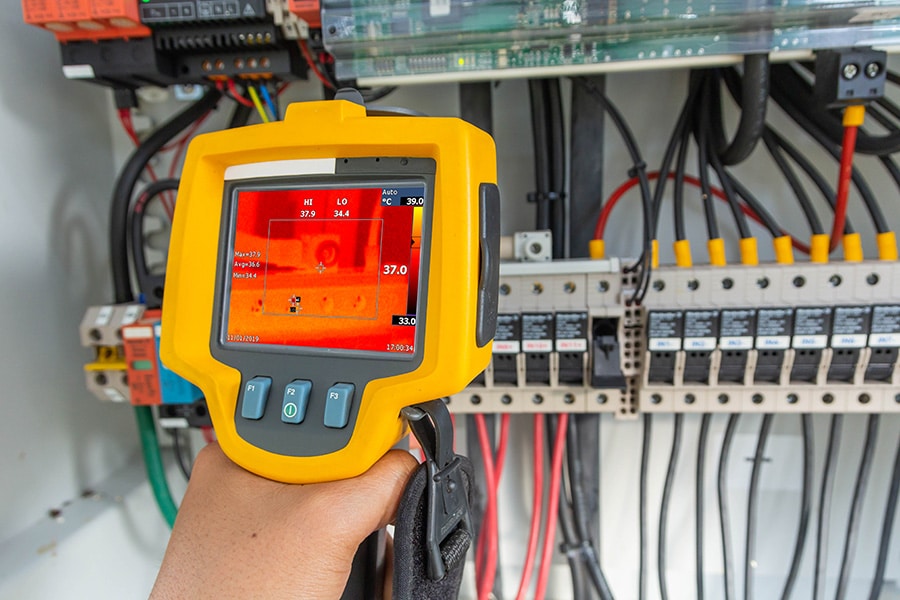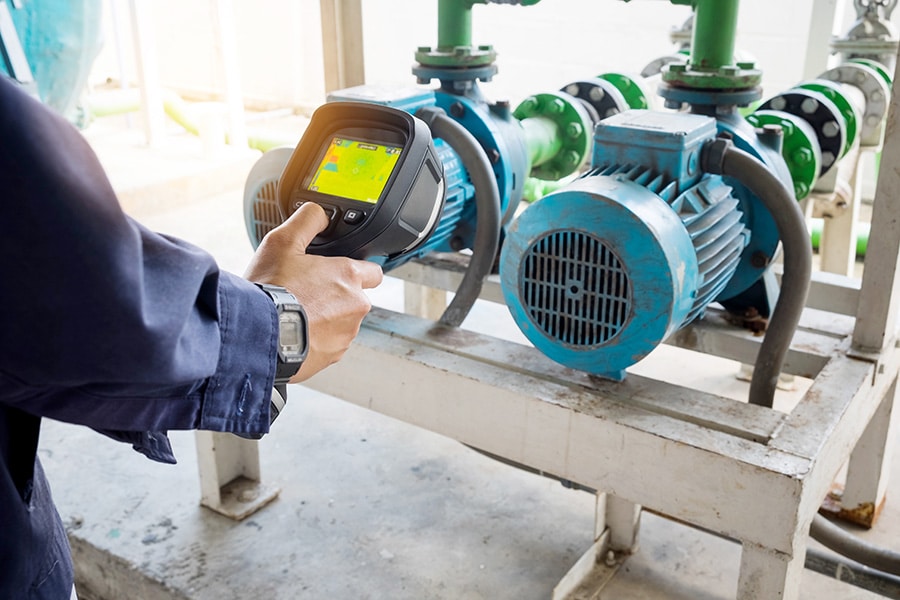Thermography and thermal imagery have been used for detection purposes since the 1950s. It has a wide variety of capabilities in facility management. At Agilix Solutions, our certified technicians are trained to utilize thermography to detect abnormalities in equipment temperature that could adversely affect facility operations.
What Is Thermography?
Infrared thermographic assessments use heat pattern detections to visualize normal and abnormal patterns that are caused by poorly functioning products or applications in a given structure. Thermography is a non-contact, non-destructive examination performed using a state-of-the-art imaging tool to determine if a facility has any irregular or unexpected thermal patterns or temperature differentials.

The Benefits of a Thermography Maintenance Assessment
Many Agilix Solutions customers rely on regular thermography assessments to proactively plan their maintenance schedules and allocate the appropriate resources. In other cases, customers know they can call on our service team to help troubleshoot before something goes wrong or help diagnose where a problem exists. There are many benefits to the process:
- Avoid costly equipment failure. A proactive approach will help set the maintenance timelines for your mission-critical equipment. This helps you keep your operations running smoothly, while avoiding costly repairs and department shutdowns.
- Establish baseline data. Regular thermography assessments can lead to a greater understanding of the typical function of your equipment or facility. Irregularities can be spotted, and problems can be addressed before they become maintenance nightmares.
- Insurance considerations. Many insurance agencies today require thermography assessments, and some even offer a discount for showing that you’ve performed one in your facility.
Our Team of Thermography Professionals
Assessments are performed by an Agilix Solutions resource, who has completed Thermal/Infrared Thermography Level 1 Certification through the Snell Group’s 34-hour course of study conforming to the guidelines of the American Society for Nondestructive Testing (ASNT) SNT-TC-1A (2006). Each has also completed an NFPA70E Electrical Safety and Arc Flash Compliance course.
Each professional is trained to complete detection in electrical, motor and numerous other functions, ranging from water flow to refrigeration. They leverage state-of-the-art equipment that allows for enhanced identification, analysis and reporting.
The Thermography Process
The technician begins with a walk through of your facility prior to the actual data collection. This initial step is recommended to identify areas of measurement and review procedural or safety issues. The technician, along with a company escort, ensures that the resources are used effectively and that the process will be efficient.
A typical thermography assessment can examine up to 10 electrical panels in an hour on average. The time range varies based on the complexity and distance to access a device.
Once collection is complete, our team will analyze the data and prepare a report with findings and recommendations.
Agilix Solutions will return at no cost to perform a courtesy check of any areas that were repaired as a result of the report.
Thermography Maintenance Applications
There are many areas in a facility where a thermography inspection can be beneficial. Leveraging the process and equipment noted above, the following applications are common for thermography:
1. There are a range of inspections to help identify problems if left unchecked:
- Deteriorated Connections. Compare temperatures of connections and switch contacts, and look for abnormally hot or cool connections.
- Three-Phase Unbalance and Overloads. Compare temperatures between phases on high-load connections. An abnormally hot phase can indicate equipment unbalance or overload.
- Substations. Examine transformers and compare similar connections under similar loads, looking for hot or cool anomalies. Heat can be caused by harmonics, connection degradation, unbalance or overload.
2. How thermography applies to motors
There are many moving parts and pieces that can create heat, and when that heat isn’t in line with specifications, failure can occur if the issues aren’t addressed:
- Bearing and Shaft. Compare bearing and housing temperature against baseline images or other known acceptable thermal values. Compare end bell to end bell or stator to end bell temperatures.
- Use the exterior thermal gradient as an indicator of the internal temperature. Other components should not be as hot as the motor housing. Each 10°C rise above its rated temperature cuts a motor’s life in half.
- A properly functioning gearbox runs temperatures slightly above ambient, about the same as the motor housing case. Hot spots often appear in cases of low lubricant in the gears.
3. Other Thermography Maintenance Applications
While electrical and motor applications are among the most common and top-of mind, many Agilix Solutions customers leverage our thermography tools in other areas of the facility:
- Pipes – Temperature anomalies which may indicate leaks
- Ducts – Blockages and leaks in ventilation systems
- Valves and Traps – Inspection for proper operation
- Tanks and Vessels – Identification of settling or blocking of tubes
- Roofs – Detection of leaks and proper seals
- Insulation Defects – Identification of gaps in wall and ceiling, in individual rooms or the building envelope
- Refrigerated Locations – Inspection for proper seals
- Hydraulic Systems – Identification of potential failure points within hydraulic systems
- IT/Computer Rooms – Detection of hot spots that may need additional cooling
The applications for thermography in your facility are widespread. We look forward to supporting your maintenance and facility management through thermography.
For more information, or to discuss a specific need in your facility, please contact your Account Manager or connect with us online today.

